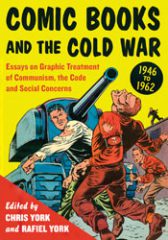The comic books of the post WWII years differ in many respects from their predecessors. For one reason, they (generally) invented new dangers, new villains and new challenges for the keepers of the peace, fighters for freedom and justice, aka the Superheroes and the Federal Agents, the T-Men, a moniker for government agents of the US Treasury Department. The fresh generation of threats from the years 1946-1962 consisted of additional dangers such as secret agents, super weapons and most of all an abstract form of a threat: namely, communism.
 But not only were dark powers at work here that wanted to enter the minds of many innocent American citizens. These powers seemingly were planning to overthrow the most precious two things to any American: freedom and the American way of life.
But not only were dark powers at work here that wanted to enter the minds of many innocent American citizens. These powers seemingly were planning to overthrow the most precious two things to any American: freedom and the American way of life.
Many comic book heroes of that era then had to use methods of criminal detection, counter-espionage and a new set of tactics that differed strongly from the simple use of supernatural powers, extreme speed or force. However, this did not mean that abnormal powers were useless in the American fight against communism. As a matter of fact, more often than before and during the war, from 1946 onwards many more ordinary Americans (or their foreign allies) had to encounter and uncover evil plots, communist propaganda, unveil beautiful female communist agents and offer to risk their lives for the American homeland.
Nevertheless, superpowers never went out of style completely; DC Comics, for example, in 1955 decided to reinstate some of their somewhat retired super heroes, and for instance, brought back The Flash in a slightly new version. For the conception of speed was also changed then, since deadly rockets from Russia finally could reach the US in a matter of minutes; to have somebody like The Flash as an Ace up one’s sleeve must have been reassuring…
All of those changes in comic book culture are to be analyzed while keeping in mind “the code” (aka the Code of the Comics Magazine Association of America. Inc., adopted in October 1954). Just as the code for American movies (the Motion Picture Production Code from 1930) the comic’s code stated that persons of law enforcement, priests, judges were to be portrayed with respect, extramarital sexual relationships were to be doomed and the villain had to be punished in the end.
Crime in general had to be portrayed as the bad alternative that sooner or later would send the criminal to jail or to the chair and no explicit detail of preparation or carrying it out was to be shown. So much for the theory; since also the racist and harmful portrayal of minorities, other ethnics, non-Christian religions were officially forbidden by the code but these mostly continued with just little alterations.
By creating comic book stories with focus on aspects of everyday life in the 50s and 60s, it seems obvious that – apart from stereotypical drawings of “the reds,” the “pinks,” or the “commies” in sometimes a rather simplified manner – the possible “threat” was seemingly everywhere. With this attitude, comic books more or less supported the government’s attitude, as it had done already during WWII.
And this why the book reviewed here has the subtitle “Essays on Graphic Treatment of Communism, the Code and Social Concerns”. Senator McCarthy’s witch hunts and a form of general paranoia concerning possible socialist intrusion came about with governmental support and was then part of many pamphlets, radio specials, newspaper articles, novels, motion pictures and even classroom agenda.
According to this paranoia, communist agents could possibly be found in any social position, posing as your colleague at work, your kid’s schoolteacher, the renowned scientist or even your spouse. While the comics typically omitted to go into detail about socialism and the theories behind it, they, nevertheless, showed clear and distinct areas of influence (soft and hard targets, so to speak) where enemy agents were likely to hit, such as public transport, industrial plants, military compounds, water and power supply or even radio and newspapers. There communist propaganda could be inserted into jingles, commercials or entertainment programs. And it took a Superhero, a federal agent or the average Joe to fight that particular threat successfully; in the comic book, the true and patriotic American typically won the battle since he was easily identifiable as the morally superior.
There have been so many different aspects of cold war politics in everyday American life, that some of them can be identified and put into categories, as the sixteen essays of Comic Books and the Cold War, varying in quality and style, try to point out.
And thereby giving just a sample of how diverse such areas are. Since not only concerns of national security were changing; alongside was a modern image of courting, dating, the role of minorities, working women, homosexuality, unknown forms of juvenile delinquency and an altogether changing attitude towards gender relationships. The collection won the Ray and Pat Browne Award from the Popular Culture Association in 2012.
A great and entertaining collection of essays for comic collectors and anybody interested in the social aspects of life in 1950’s America.
Review by Dr. A. Ebert (c) 2013
Chris York and Rafiel York (eds.) Comic Books and the Cold War, 1946-1962: Essays on Graphic Treatment of Communism, the Code and Social Concerns. McFarland, 2012, 223 p.
